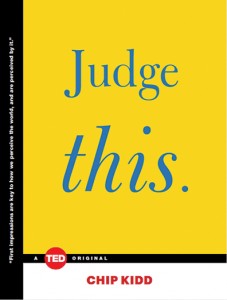
How will you be seen?
That’s a big concern for you on many days: will your mode of dress impress or are you feeling frumpy? Can a strong handshake overcome onions for lunch? There are, of course, no second chances at a first impression, and in “Judge This” by Chip Kidd, you’ll learn how to make an initial splash.
You can’t judge a book by its cover – or so your mother said more than once when you were growing up. But what if Mom was wrong?
“First impressions,” says Chip Kidd, “are key to how we perceive the world…. And based on our first impressions, we judge things. We can’t help it.” In fact, you want your clients and co-workers to judge your product and design because, if they don’t, “… that’s a problem.”

The other tool Kidd mentions is Mystery, which is “extremely powerful” because it can tickle an audience’s fancy by making them work to get the message. It’s like an itch or a “secret code you want to crack,” and it’s “much more complex than clarity…” Again, caution is needed when using Mystery; in fact, Kidd says that, in his job as a book cover designer, he tries “to create a balance between” the two design tools.
Using his “Mysteri-o-meter,” a graph he created to rate the design and advertising examples he includes, Kidd explains how he (and others) may judge items in their surroundings and what, if anything, could have been done to make those items or ads different. He looks at the obviously simple (binder clips) and the complicated (a sentence in a book that led to a specific cover). He re-writes handbills, examines classic furniture, and explains why movie posters are the way they are.
And then he judges them.
So your ad budget just isn’t getting the results you need? That new design is tanking? “Judge This” may help you see why.
And then, on the other hand, it might not.
Without a doubt, it’s helpful to know the two basic design aspects you can employ to sway potential buyers, and how to better use them. You may learn to cultivate a keener eye here, and that’s always good. But the judgments and conclusions that author Chip Kidd offers are, I noticed, mostly personal. He’s spot-on with some observations but with others, I would’ve disagreed. That these things are often based on opinion is something readers will want to remember.
And yet, based on a TED talk, this book is informative, lighthearted, double-quick to read, and it may open some eyes. And if that’s what you – or your design team – needs, then “Judge This” needs to be seen.
The Bookworm is Terri Schlichenmeyer. Terri has been reading since she was 3 years old and she never goes anywhere without a book. She lives on a hill in Wisconsin with two dogs and 12,000 books.
